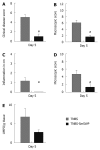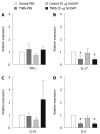Schistosoma mansoni proteins attenuate gastrointestinal motility disturbances during experimental colitis in mice
- PMID: 20135718
- PMCID: PMC2817058
- DOI: 10.3748/wjg.v16.i6.703
Schistosoma mansoni proteins attenuate gastrointestinal motility disturbances during experimental colitis in mice
Abstract
Aim: To investigate the therapeutic effect of Schistosoma mansoni (S. mansoni) soluble worm proteins on gastrointestinal motility disturbances during experimental colitis in mice.
Methods: Colitis was induced by intrarectal injection of trinitrobenzene sulphate (TNBS) and 6 h later, mice were treated ip with S. mansoni proteins. Experiments were performed 5 d after TNBS injection. Inflammation was quantified using validated inflammation parameters. Gastric emptying and geometric center were measured to assess in vivo gastrointestinal motility. Peristaltic activity of distal colonic segments was studied in vitro using a modified Trendelenburg set-up. Cytokine profiles of T-lymphocytes isolated from the colon were determined by real time reverse transcriptase-polymerase chain reaction.
Results: Intracolonic injection of TNBS caused severe colitis. Treatment with S. mansoni proteins significantly ameliorated colonic inflammation after 5 d. TNBS did not affect gastric emptying but significantly decreased the geometric center and impaired colonic peristaltic activity 5 d after the induction of colitis. Treatment with S. mansoni proteins ameliorated these in vivo and in vitro motility disturbances. In addition, TNBS injection caused a downregulation of effector T cell cytokines after 5 d, whereas a S. mansoni protein effect was no longer observed at this time point.
Conclusion: Treatment with S. mansoni proteins attenuated intestinal inflammation and ameliorated motility disturbances during murine experimental colitis.
Figures





Similar articles
-
Therapeutic potential of helminth soluble proteins in TNBS-induced colitis in mice.Inflamm Bowel Dis. 2009 Apr;15(4):491-500. doi: 10.1002/ibd.20787. Inflamm Bowel Dis. 2009. PMID: 19023900
-
Concurrent infection with Schistosoma mansoni attenuates inflammation induced changes in colonic morphology, cytokine levels, and smooth muscle contractility of trinitrobenzene sulphonic acid induced colitis in rats.Gut. 2004 Jan;53(1):99-107. doi: 10.1136/gut.53.1.99. Gut. 2004. PMID: 14684583 Free PMC article.
-
Acute distal colitis impairs gastric emptying in rats via an extrinsic neuronal reflex pathway involving the pelvic nerve.Gut. 2007 Feb;56(2):195-202. doi: 10.1136/gut.2006.104745. Epub 2006 Sep 14. Gut. 2007. PMID: 16973715 Free PMC article.
-
Effect of recombinant serine protease from adult stage of Trichinella spiralis on TNBS-induced experimental colitis in mice.Int Immunopharmacol. 2020 Sep;86:106699. doi: 10.1016/j.intimp.2020.106699. Epub 2020 Jun 20. Int Immunopharmacol. 2020. PMID: 32570037
-
Therapeutic potential of recombinant cystatin from Schistosoma japonicum in TNBS-induced experimental colitis of mice.Parasit Vectors. 2016 Jan 4;9:6. doi: 10.1186/s13071-015-1288-1. Parasit Vectors. 2016. PMID: 26728323 Free PMC article.
Cited by
-
Helminthes and insects: maladies or therapies.Parasitol Res. 2015 Feb;114(2):359-77. doi: 10.1007/s00436-014-4260-7. Epub 2014 Dec 30. Parasitol Res. 2015. PMID: 25547076 Review.
-
Gestation and breastfeeding in schistosomotic mothers differently modulate the immune response of adult offspring to postnatal Schistosoma mansoni infection.Mem Inst Oswaldo Cruz. 2016 Feb;111(2):83-92. doi: 10.1590/0074-02760150293. Mem Inst Oswaldo Cruz. 2016. PMID: 26872339 Free PMC article.
-
Therapeutic potential of helminths in autoimmune diseases: helminth-derived immune-regulators and immune balance.Parasitol Res. 2017 Aug;116(8):2065-2074. doi: 10.1007/s00436-017-5544-5. Epub 2017 Jun 29. Parasitol Res. 2017. PMID: 28664463 Review.
-
Therapeutic effect of Qingyi decoction in severe acute pancreatitis-induced intestinal barrier injury.World J Gastroenterol. 2015 Mar 28;21(12):3537-46. doi: 10.3748/wjg.v21.i12.3537. World J Gastroenterol. 2015. PMID: 25834318 Free PMC article.
-
The hygiene theory harnessing helminths and their ova to treat autoimmunity.Clin Rev Allergy Immunol. 2013 Oct;45(2):211-6. doi: 10.1007/s12016-012-8352-9. Clin Rev Allergy Immunol. 2013. PMID: 23325330 Review.
References
-
- Bamias G, Cominelli F. Novel strategies to attenuate immune activation in Crohn’s disease. Curr Opin Pharmacol. 2006;6:401–407. - PubMed
-
- Podolsky DK. Inflammatory bowel disease. N Engl J Med. 2002;347:417–429. - PubMed
-
- Fiocchi C. Inflammatory bowel disease: etiology and pathogenesis. Gastroenterology. 1998;115:182–205. - PubMed
-
- Alic M. Inflammatory bowel diseases are diseases of higher socioeconomic status: dogma or reality? Am J Gastroenterol. 2000;95:3332–3333. - PubMed
Publication types
MeSH terms
Substances
LinkOut - more resources
Full Text Sources
Other Literature Sources

